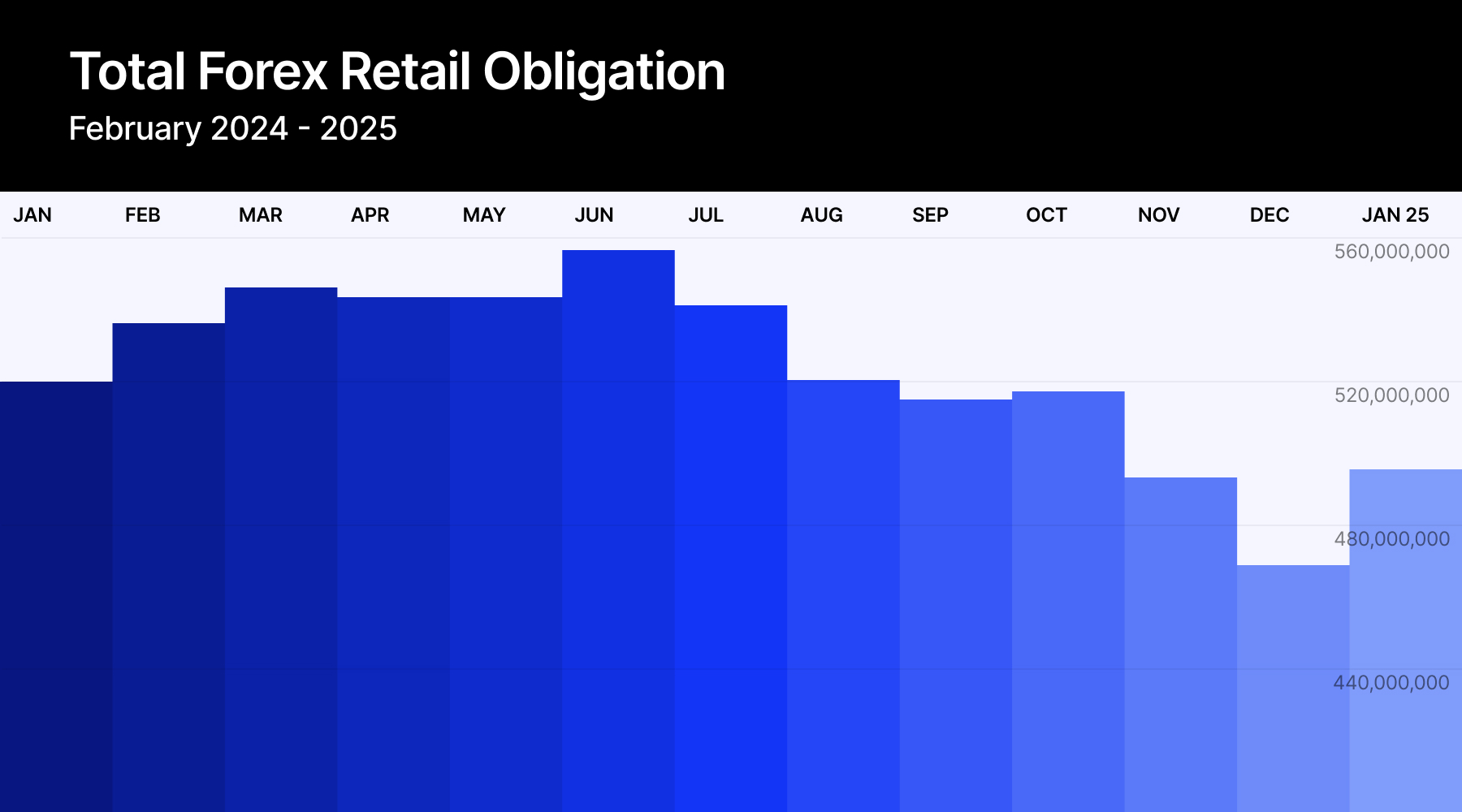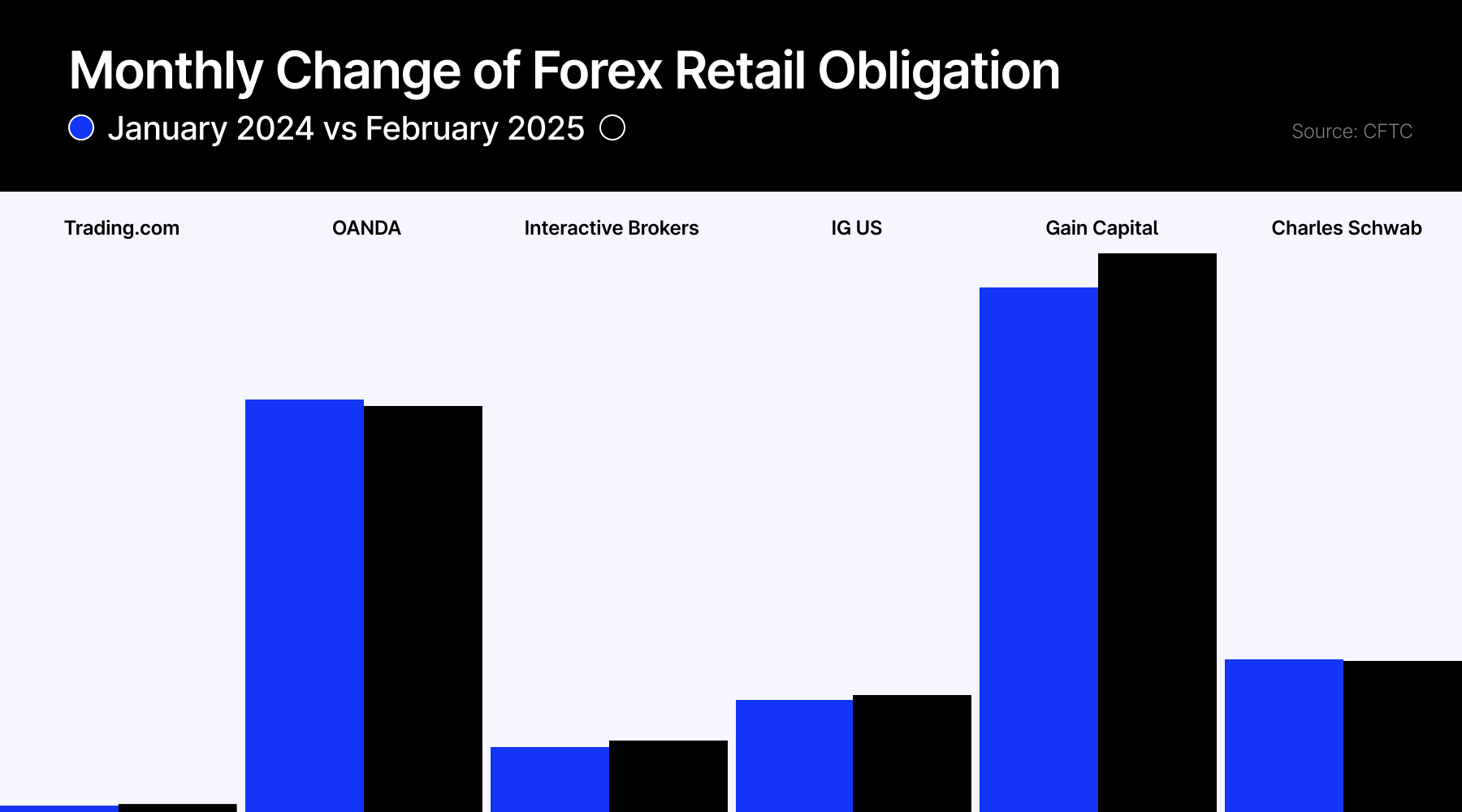U.S. retail
forex brokers held approximately $527 million in client obligations as of
February 2025, according to the latest regulatory data from the Commodity
Futures Trading Commission (CFTC).
U.S. Forex Brokers See
Client Funds Rise to $527 Million in February
The
February 2025 figures represent a 2.9% month-over-month increase
from January, when total client funds stood at approximately $512 million.
However, the data shows a 2.9% year-over-year decline compared to February
2024.
The U.S.
retail forex market remains highly concentrated, with the top three brokers
controlling over 85% of client funds. This concentration reflects the
significant regulatory barriers to entry in the U.S. market, including the $20
million minimum capital requirement for forex dealers.

Six Brokers Control Entire
US Retail Forex Market
Six
registered retail foreign exchange dealers (RFEDs) currently dominate the U.S.
forex market: Gain Capital, Oanda, Charles Schwab, IG US, Interactive Brokers,
and Trading.com.
Gain
Capital maintained its position as the market leader, holding $225 million in
client funds as of February 2025, representing approximately 42.7% of the total
market. This marks a 6% increase from January 2025 and
a 7% year-over-year growth compared to February 2024.
Oanda
remains the second-largest forex broker with $163.2 million in client
obligations , though this represents a 1.5% decrease from January. Charles
Schwab holds the third position with approximately $61 million in client funds.

Smaller Players and Market
Volatility
The data
reveals significant volatility for some smaller market participants. IG US
reported $46.7 million in client funds, showing a 3% monthly increase but a
substantial 23.8% year-over-year decline. Interactive Brokers experienced the
most significant monthly growth among major brokers, with client funds
increasing 9.5% to $28.6 million.
Trading.com,
while maintaining the smallest market share among the six registered dealers,
demonstrated the strongest percentage growth. The broker reported $2.5 million
in client funds, a 9.2% increase from January and a 36.2% growth compared to
February 2024.
Regulatory Compliance
The CFTC
requires all registered forex dealers to maintain substantial capital reserves
to protect client funds. According to the regulatory filing, all six brokers
currently meet or exceed the minimum capital requirements established by the
commission.
The monthly
data is compiled from financial reports submitted by registered futures
commission merchants (FCMs) and retail foreign exchange dealers to the CFTC.
U.S. retail
forex brokers held approximately $527 million in client obligations as of
February 2025, according to the latest regulatory data from the Commodity
Futures Trading Commission (CFTC).
U.S. Forex Brokers See
Client Funds Rise to $527 Million in February
The
February 2025 figures represent a 2.9% month-over-month increase
from January, when total client funds stood at approximately $512 million.
However, the data shows a 2.9% year-over-year decline compared to February
2024.
The U.S.
retail forex market remains highly concentrated, with the top three brokers
controlling over 85% of client funds. This concentration reflects the
significant regulatory barriers to entry in the U.S. market, including the $20
million minimum capital requirement for forex dealers.

Six Brokers Control Entire
US Retail Forex Market
Six
registered retail foreign exchange dealers (RFEDs) currently dominate the U.S.
forex market: Gain Capital, Oanda, Charles Schwab, IG US, Interactive Brokers,
and Trading.com.
Gain
Capital maintained its position as the market leader, holding $225 million in
client funds as of February 2025, representing approximately 42.7% of the total
market. This marks a 6% increase from January 2025 and
a 7% year-over-year growth compared to February 2024.
Oanda
remains the second-largest forex broker with $163.2 million in client
obligations , though this represents a 1.5% decrease from January. Charles
Schwab holds the third position with approximately $61 million in client funds.

Smaller Players and Market
Volatility
The data
reveals significant volatility for some smaller market participants. IG US
reported $46.7 million in client funds, showing a 3% monthly increase but a
substantial 23.8% year-over-year decline. Interactive Brokers experienced the
most significant monthly growth among major brokers, with client funds
increasing 9.5% to $28.6 million.
Trading.com,
while maintaining the smallest market share among the six registered dealers,
demonstrated the strongest percentage growth. The broker reported $2.5 million
in client funds, a 9.2% increase from January and a 36.2% growth compared to
February 2024.
Regulatory Compliance
The CFTC
requires all registered forex dealers to maintain substantial capital reserves
to protect client funds. According to the regulatory filing, all six brokers
currently meet or exceed the minimum capital requirements established by the
commission.
The monthly
data is compiled from financial reports submitted by registered futures
commission merchants (FCMs) and retail foreign exchange dealers to the CFTC.
This post is originally published on FINANCEMAGNATES.

